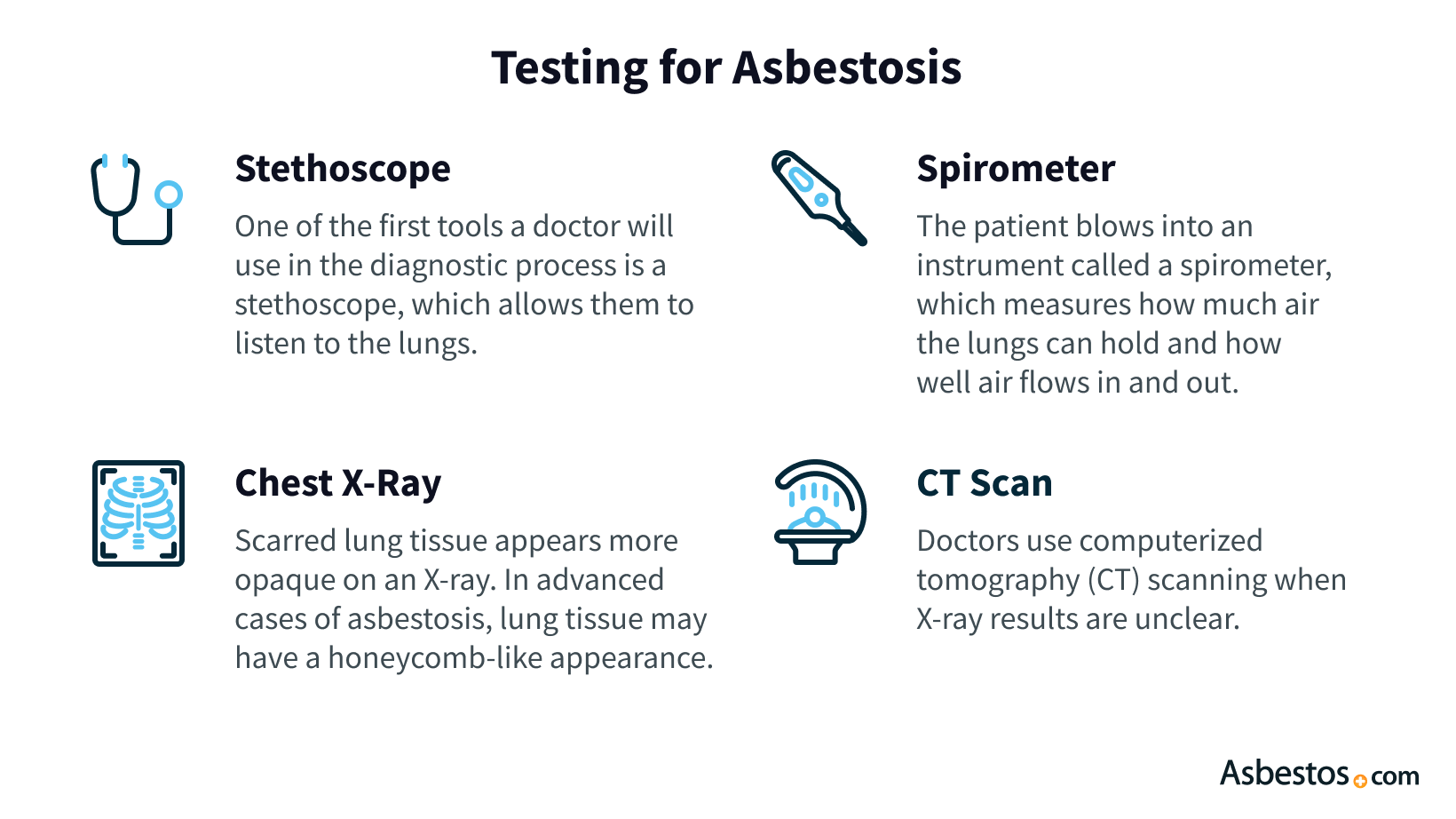Get Your Free Mesothelioma Guide

Find a Top Mesothelioma Doctor

Access Help Paying for Treatment

Asbestosis symptoms include dry cough, shortness of breath and swelling in the face or neck. These typically emerge after 20 years, complicating diagnosis. Doctors use medical history, tests and scans to diagnose asbestosis. It requires expertise to confirm the disease and plan treatment.

Common signs and symptoms of asbestosis affect a person’s ability to breathe, including chest pain and shortness of breath. A crackling sound in the lungs that doctors can listen for with a stethoscope is another symptom for determining a diagnosis. The severity and frequency of asbestosis symptoms can vary.
Common Asbestosis Symptoms
Many of the these symptoms are also present with pleural mesothelioma cancer, which is the most common type of malignant mesothelioma cancer. Doctors look for these symptoms and perform various pulmonary and breathing function tests to reach a diagnosis. Patients can keep track of their symptoms, noting the frequency and intensity, to share with their health care provider.
In most asbestosis patients, symptoms develop within 20 to 30 years after asbestos exposure. For some people who experience exposure repeatedly over a decade or more, the latency period of symptom development may be less.
Key Facts About Asbestosis Symptoms and Diagnosis
Asbestos fibers are microscopic in size, sharp and straight. During exposure, inhaled asbestos particles can become lodged in lung tissue. The shape and texture of the fibers make it difficult for the body to dislodge and expel. Over time, the fibers cause irritation, inflammation and scarring, which leads to symptoms that primarily affect the lungs.
Doctors recommend several treatment options to help relieve asbestosis symptoms, including surgery, medication, or breathing exercises and techniques. While there’s no cure for asbestosis, these therapies can help manage symptoms and lessen their severity.
Ways to Manage Asbestosis Symptoms
Lifestyle changes, using inhalers or taking supplemental oxygen can make a difference in symptom severity and frequency. All patients, regardless of the presence of symptoms, should attend regular exams with their doctor and undergo all recommended screenings, such as a chest X-ray or lung CT scan to detect disease. Seek medical attention immediately for any new or worsening symptoms.
Get Your Free Mesothelioma Guide

Find a Top Mesothelioma Doctor

Access Help Paying for Treatment

Lifestyle adjustments like quitting smoking, changing your diet and exercising can help. Patients should quit smoking because it worsens symptoms and speeds up its progression. A nutritious, balanced diet low in salt that emphasizes water intake aids symptom management. It’s also important to stay active to keep lung fitness and function high.
Several alternative therapies may provide some relief, but patients should talk with their doctor before taking anything new. Herbs like astragalus or slippery elm bark may ease coughs and improve respiratory function. But these and other natural treatments can trigger allergic reactions or interact with prescription drugs. Patients should speak with their doctor to get advice on what to take or avoid.
Doctors may prescribe several types of medications for asbestosis symptom relief. The disease has no specific treatment regimen, so the best medications depend on each patient’s symptoms, medical history and overall health.
Medications for Asbestosis
Patients who have prescription medications should take them exactly as their doctor recommends. Never stop a medication without first speaking with a physician. Patients should track all changes in symptoms and health and report them to their doctor.
Pulmonary rehabilitation is a program to manage symptoms with exercises and increased awareness. This therapy focuses on teaching patients how to make helpful lifestyle changes to better handle ongoing breathing difficulties.
Therapists teach a variety of breathing exercises and techniques that improve lung function and strength, leading to a better quality of life. Some patients’ breathing is computer-monitored to provide feedback. Increased awareness combined with breathing exercises can help the patient breathe easier. They can learn to control their breathing even during periods of stress or physical activity.
Doctors may recommend lung transplant surgery to relieve symptoms and halt disease progression. Providers typically only recommend a lung transplant when the patient battles another condition like lung cancer. A U.S. National Library of Medicine review found severe asbestosis cases may require a lung transplant as a last-resort treatment.
The 1-year survival rate for lung transplant patients is around 80%, but aggressive surgery is often viewed as a last resort. Patients who undergo aggressive surgery or have severe symptoms can also consider palliative treatment to manage their pain and other symptoms to improve their quality of life.
Asbestosis is one of the more difficult asbestos-related conditions to diagnose because it is like other conditions. While many asbestos-related conditions share symptoms, most have a few strong distinguishing factors. This isn’t the case for asbestosis.
As this table demonstrates, the symptoms of asbestosis are shared with many other asbestos-related and lung-related conditions. This means it can go misdiagnosed or entirely undiagnosed for years at a time, presenting a much greater risk when it’s finally discovered. Because of this, you should seek medical attention as soon as you suspect you may have asbestosis and get multiple professional opinions throughout the process.
Jerry Cochran felt like something else was going on since his condition was worsening. He was then diagnosed with asbestosis. He struggles to breathe because his lungs can’t expand and contract the way they’re supposed to. The paint he scraped off of the aircraft carrier he served on decades ago contained asbestos, leading to his asbestosis. The condition is incurable, but many patients can survive several decades with treatment.
Asbestosis is diagnosed with lung function tests and imaging scans that detect irregularities. The patient must have a history of asbestos exposure. Doctors use the test results in tandem with your asbestos exposure history to make a diagnosis.
Tests to identify asbestosis and other forms of lung fibrosis look for certain signs and symptoms. Examples include crackling breathing sounds, scar tissue in the lungs and pleural plaque buildup.

First, your doctor will review your medical history and conduct a physical exam. Listening to the lungs with a stethoscope can lead to further diagnostic tests.
Be sure to inform the doctor of any past exposure to asbestos or diagnoses of other asbestos-related conditions. A history of asbestos exposure is a vital factor in diagnosing asbestosis.
Doctors will take a chest X-ray followed by a CT scan. The chest X-ray creates an image of your chest cavity and the vital organs inside. Lungs with asbestosis typically appear whiter or more opaque on an X-ray. They may have a honeycomb-like appearance in severe cases.
Routine monitoring and initial diagnostic scans often involve CT scans. These create a much more detailed image of the body than X-rays, giving doctors a better idea of what conditions a patient may or may not have. A 2022 study found that a diagnostic algorithm identified asbestosis on CT scans more accurately than a radiologist.
Pulmonary function tests check how well a patient’s lungs function. If a patient’s results are low, and they’ve been exposed to asbestos in the past, a doctor may look further into an asbestosis diagnosis.
Tests may include a lung capacity test, respiratory muscle strength and performance tests for mild cardio such as a 6-minute walk. These allow your doctor to check if your lungs are working properly or overworking to compensate for any damage.
Lung biopsies are rarely used to diagnose asbestosis but can be a valuable tool. Doctors typically hesitate to perform a lung biopsy because it is invasive, but they will do so as a last resort.
To perform this test, doctors take a small sample of lung tissue and observe it under a microscope. They examine the tissue for any abnormalities, especially the presence of scarring and asbestos fibers. If they detect scarring and asbestos fibers, doctors consider the patient’s medical history and other test results to make a diagnosis.

Receive a free guide with the latest information on emerging treatments and clinical trials.
Get Yours NowGetting an asbestosis diagnosis as early as possible is crucial because it allows you to begin treatment promptly. Because treating asbestosis is mostly about managing symptoms, the earlier you start treatment, the more effective that treatment will be.
If you know you’ve been exposed to asbestos, we recommend going to regular medical screenings to find abnormalities. Whether or not you think you have asbestosis, screenings can show early signs of this disease and many other dangerous conditions.
Regular screenings can identify cancers such as mesothelioma in earlier stages and other interstitial lung abnormalities. Early treatment improves the prognosis for many of these conditions.
Doctors can run critical tests, give important advice, and prescribe the treatment you need to manage your condition and retain a high quality of life. Starting treatment before asbestosis advances maximizes your chances of a positive outcome.
When you are diagnosed with asbestosis, your doctor will assign your condition one of five grades: Grade 0 is the lowest, while grade 4 is the highest. Understanding what each grade means is important because it will affect your treatment.
The 5 Grades of Asbestosis
Typically, the amount of scarring in your lungs determines the grade of your asbestosis diagnosis. Advanced scarring indicates a more severe case, which requires a more advanced treatment plan as a result.
Receiving an asbestosis diagnosis can be jarring. While the condition is incurable, treatment for asbestosis can help reduce its impact. However, it’s essential to start as early as possible.
The first and most crucial step after receiving an asbestosis diagnosis is to avoid any further asbestos exposure. For example, if you’re working in a field with frequent occupational exposure to asbestos, consider moving to a different position within your company. Once you’re no longer exposed to asbestos, reports show that simple changes such as a healthy diet and a moderate cardio routine can sometimes manage asbestosis symptoms.
When you are diagnosed, discuss treatment and management options with your doctor. Patients who start and follow a suitable treatment plan are often able to live long and fulfilling lives following an asbestosis diagnosis.
Asbestosis has symptoms like those of many other lung conditions. Pulmonary symptoms include chest pain, crackling sounds when breathing, dry cough and shortness of breath. Other signs can include clubbing of fingers and toes, fatigue, loss of appetite and sudden weight loss.
It is difficult to identify asbestosis by its symptoms because they overlap with those of other pulmonary conditions. A doctor can order imaging scans and other tests to rule out other conditions, such as asthma and chronic bronchitis.
Immediately seek a medical opinion if you suspect you have asbestosis. This is a severe condition, and diagnosing it early is the best way to mitigate some of its effects.
Because asbestosis is indistinguishable from other forms of pulmonary fibrosis and lung scarring, it can easily be misdiagnosed. Get a second opinion to ensure you have asbestosis rather than a different condition.
Your web browser is no longer supported by Microsoft. Update your browser for more security, speed and compatibility.
If you are looking for mesothelioma support, please contact our Patient Advocates at (855) 404-4592
The Mesothelioma Center at Asbestos.com has provided patients and their loved ones the most updated and reliable information on mesothelioma and asbestos exposure since 2006.
Our team of Patient Advocates includes a medical doctor, a registered nurse, health services administrators, veterans, VA-accredited Claims Agents, an oncology patient navigator and hospice care expert. Their combined expertise means we help any mesothelioma patient or loved one through every step of their cancer journey.
More than 30 contributors, including mesothelioma doctors, survivors, health care professionals and other experts, have peer-reviewed our website and written unique research-driven articles to ensure you get the highest-quality medical and health information.
My family has only the highest compliment for the assistance and support that we received from The Mesothelioma Center. This is a staff of compassionate and knowledgeable individuals who respect what your family is experiencing and who go the extra mile to make an unfortunate diagnosis less stressful. Information and assistance were provided by The Mesothelioma Center at no cost to our family.LashawnMesothelioma patient’s daughter


Asbestos.com. (2025, January 15). Asbestosis Symptoms and Diagnosis. Retrieved April 14, 2025, from https://www.asbestos.com/asbestosis/symptoms/
"Asbestosis Symptoms and Diagnosis." Asbestos.com, 15 Jan 2025, https://www.asbestos.com/asbestosis/symptoms/.
Asbestos.com. "Asbestosis Symptoms and Diagnosis." Last modified January 15, 2025. https://www.asbestos.com/asbestosis/symptoms/.
Arti Shukla, Ph.D., is an internationally renowned asbestos researcher known for her achievements in identifying biomarkers that cause mesothelioma. She is the director of the Shukla Research Lab, as well as a professor of pathology at The University of Vermont Larner College of Medicine.
Our fact-checking process begins with a thorough review of all sources to ensure they are high quality. Then we cross-check the facts with original medical or scientific reports published by those sources, or we validate the facts with reputable news organizations, medical and scientific experts and other health experts. Each page includes all sources for full transparency.
Please read our editorial guidelines to learn more about our content creation and review process.
